The GEN Z Series travels from Delhi NCR in India to Dublin to meet an Indian student-architect Jaspreet Kaur, who is pursuing her Masters in Architecture, Urbanism and Climate Action at the University College Dublin in Ireland. Hailing from Bangalore, she graduated with a B. Arch degree from the B M S College of Engineering, Bangalore in Karnataka, India. Interestingly, her aunty is an interior architect.
Coming from a rich academic background, Jaspreet Kaur reveals, “My father works as a dedicated medical scribe, while my mother passionately imparts knowledge as an English teacher. Raised in a humble Sikh household, I attribute much of my character to the values instilled by my parents and elder sister (smiles). Growing up amidst their dedication and hard work, I have strived to excel academically. I’ve nurtured my interests in sketching, painting, and photography, as they add colour to my pursuits.”

Prakruti – The Green School
Jaspreet Kaur’s commitment and concerns towards Planet Earth has made her to pursue her Masters in the related field. She enthuses, “I have always been concerned about the environmental impacts of architecture and am keen on working towards the sustainable transformation of the construction industry. With my determination, I hope to make a positive impact through my personal and professional endeavours.”
Meticulous in her approach and creative to the core, Jaspreet Kaur’s thesis ‘Prakruti – The Green School’ reflects her individual persona. Johnny D interacts with Jaspreet Kaur to explore her journey into the architecture field.

Master Plan
What was your childhood ambition? Did you always wanted to become an architect?
Since the age of twelve, I have always wanted to be known as an architect, even though I did not exactly comprehend what it meant at the time (smiles). The aspiration was instinctive. Eventually, I was drawn to the multi-disciplinary nature of architecture. My academic brightness and love for creative expression just seemed like the perfect path for me.
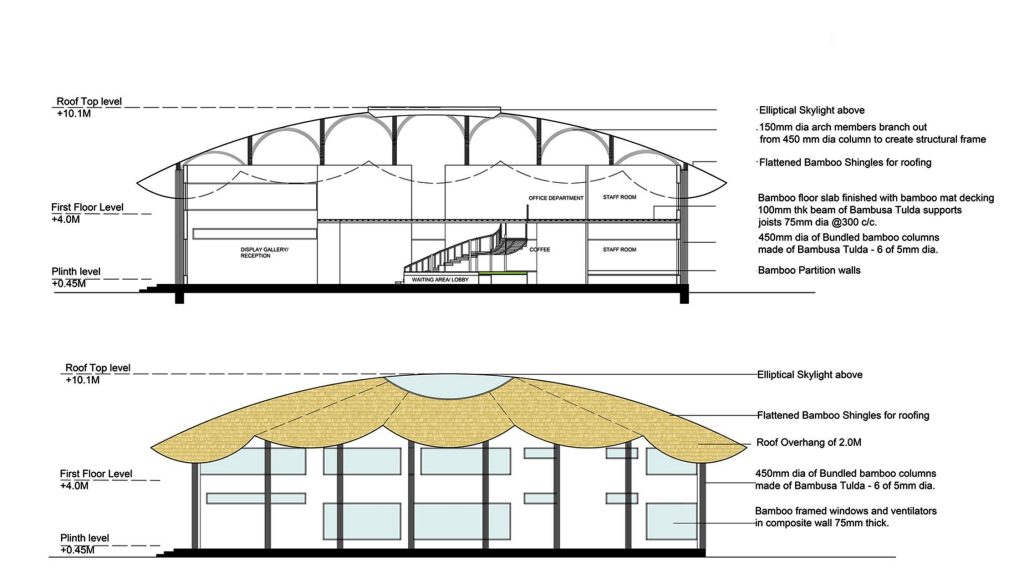
Admin Block
How has architecture influenced your life as a student?
Architecture has taught me the power of ‘Empathy’. Understanding the needs and experiences of the occupants, as well as the impact of the built space on the natural environment has led me to approach design with empathy towards people and the environment. My journey through architecture school has shaped my professional skills and my character. The critiques and juries have instilled in me patience, perseverance, humility and resilience – qualities that are essential for navigating the challenges of the field, and life itself.
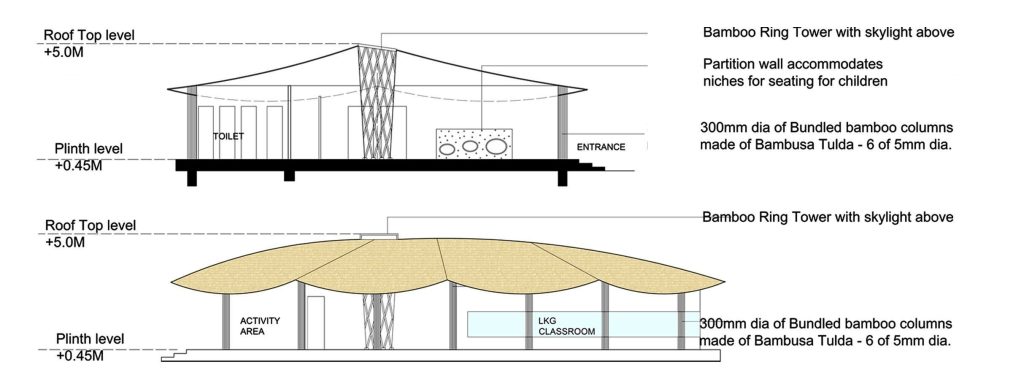
Kindergarten Block
What were the challenges you had to face at University College Dublin after completing your B. Arch from BMS College of Engineering, Bangalore?
While adjusting to the academic environment, I found the assignment briefs to be particularly challenging. However, I appreciate the creativity embedded within them, such as creating a podcast or pitching for an innovation prize, which have been enjoyable and stimulating. Engaging in these assignments has allowed me to explore my potential and has surprised me with the level of creativity, I have been able to achieve in the final output (smiles).
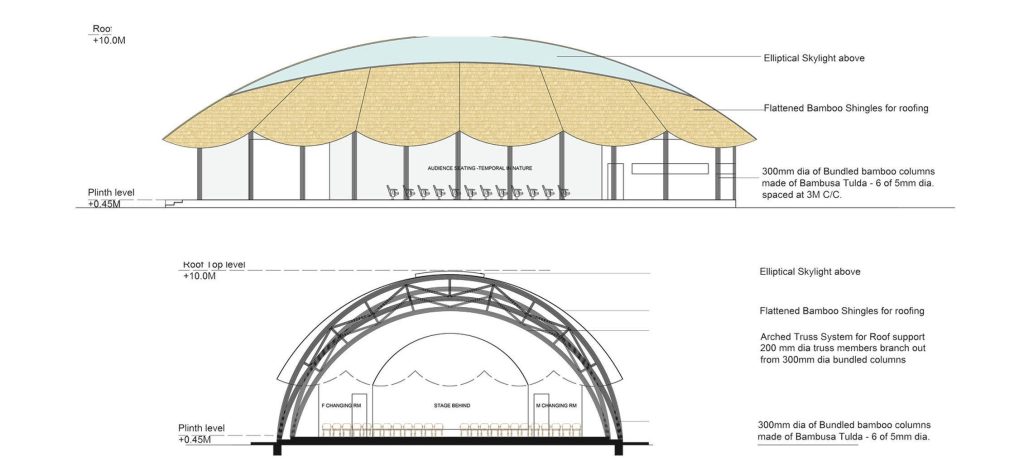
Auditorium
Briefly tell us about your University and Master’s Course.
I am currently enrolled in the Master’s program in Architecture, Urbanism and Climate Action at University College Dublin. This course has broadened my understanding of climate science and policy, GIS, Life cycle assessments of buildings, building retrofits, systems thinking and environmental ethics, equipping me with skills necessary for sustainable and inclusive building and urban design in an era of climate change. The program also offers a diverse range of optional modules.
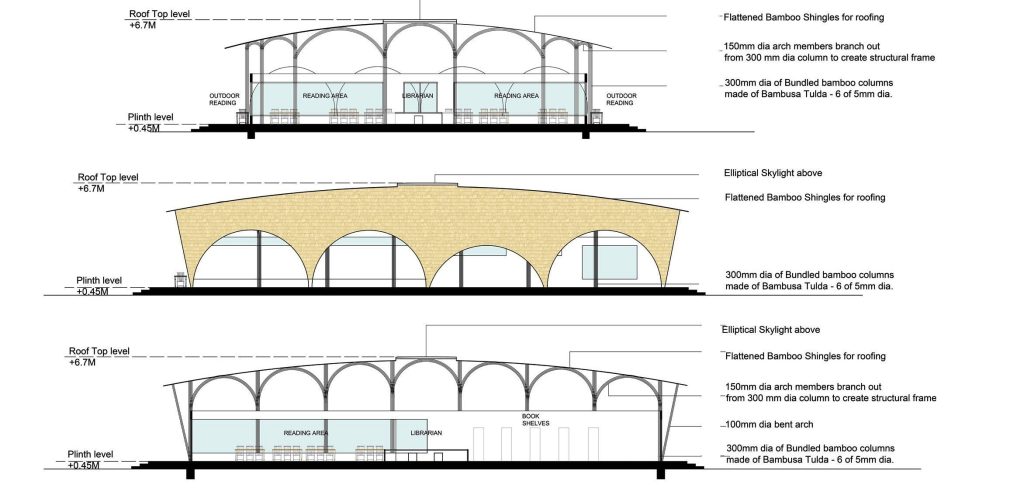
Library Block
Briefly describe the significance of your project with the ‘Title of the Project and Site Location’.
My undergraduate thesis ‘Prakruti (meaning ‘Nature’ in Sanskrit) – The Green School’ aimed to instill pro-environmental behavior in children. Researching the concept of ‘Teaching green building’, I focused on bamboo as a sustainable construction material, locally available in the bamboo markets of Bangalore.
Drawing inspiration from the Green School in Bali and an insightful conversation with Architect Neelam Manjunath – ‘the Bamboo lady of India’, I studied and explored the techniques and properties of bamboo to design an eco-friendly school campus characterized by fluid roof forms.
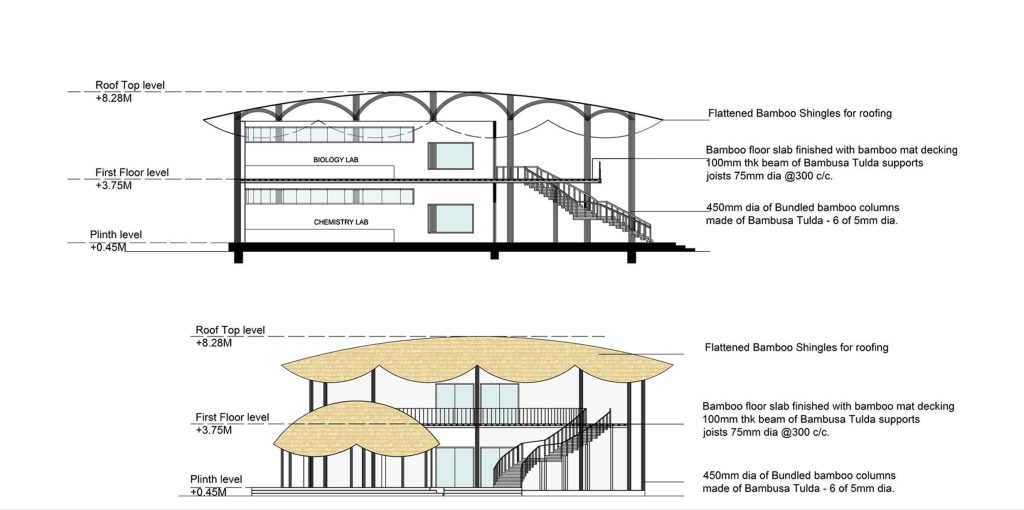
Labs and Workshop Block
The 4.6-acre site was carefully chosen within GKVK, a Bangalore Agricultural Institute, which offered rich biodiversity and existing demonstrations of eco-initiatives like vermicomposting, solar parks, as well as sewage treatment and reuse. The site was planned considering site orientation and topography. The master plan was inward-looking, featuring a central open space serving as a multifunctional space, surrounded by various blocks such as admin, classrooms and workshops. These blocks, shaped like leaves of a tree, branched out from the central space and were strategically oriented around organic gardens accessible to students, both visually and physically.
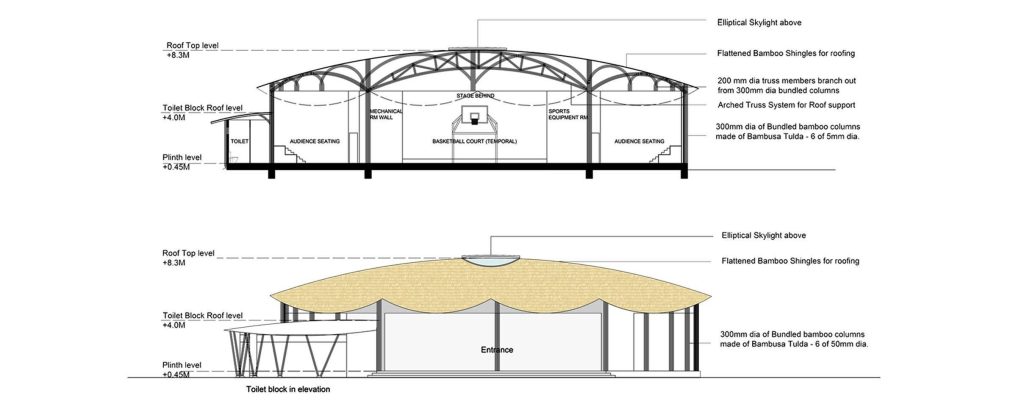
Sports Block
Notably, the canteen integrated with an aquaponics facility was designed to appear as though floating on a water catchment, enhancing the immersive learning experience. It was envisioned that children could harvest fruits and vegetables from these gardens and cook without fire in the kitchen. Overall, ‘Prakruti – The Green School’ envisioned a sprawling campus where children could engage in hands-on architectural exploration, while fostering a deep connection with nature.
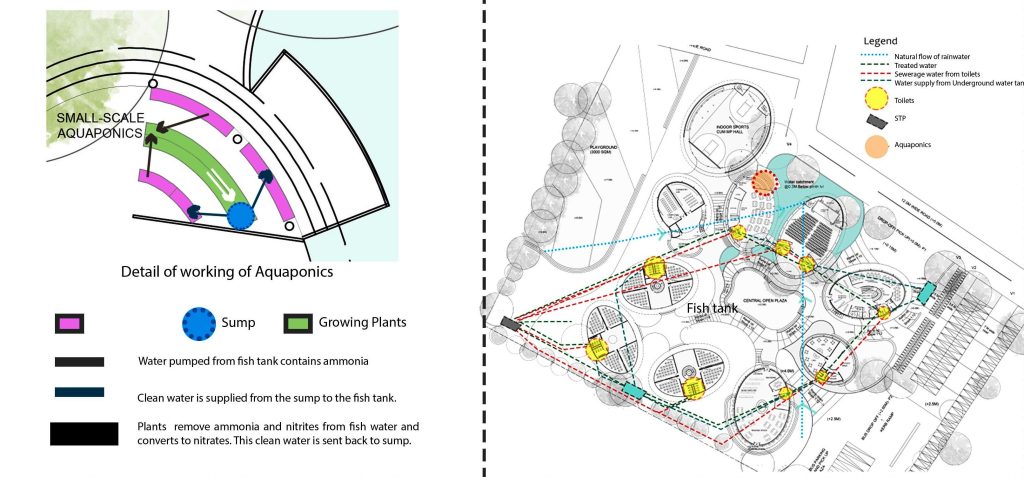
Aquaponics and Services
Which National or International architect has inspired / influenced you? Please specify as to why?
I have always been inspired by Antoni Gaudi, who was himself greatly influenced by Nature. Nature exists beautifully in the most efficient, functional, and incomprehensible forms. Gaudi’s creations mimic nature through organic and harmonious structures with intricate detailing and biomimetic elements. His innovations in construction techniques like hyperbolic paraboloids and catenary arches led to the creation of whimsical buildings that fascinate and excite me. What I appreciate the most about Gaudi is his novel ideas and ability to think differently!

Handmade Model
As an Intern, what is the most important lesson(s) you have learned from senior architects, while being a part of a project?
I have learned some invaluable lessons from my senior architects, during my one-year work experience. Firstly, I learned the importance of thoroughness in work, which enables one to navigate through any situation effortlessly. This quality develops with experience. When faced with challenges, maintaining a calm response rather than reacting impulsively is the key. Equally important is clear communication with all stakeholders – clients, consultants and contractors, while diligently documenting these interactions to prevent potential confusion in the future.
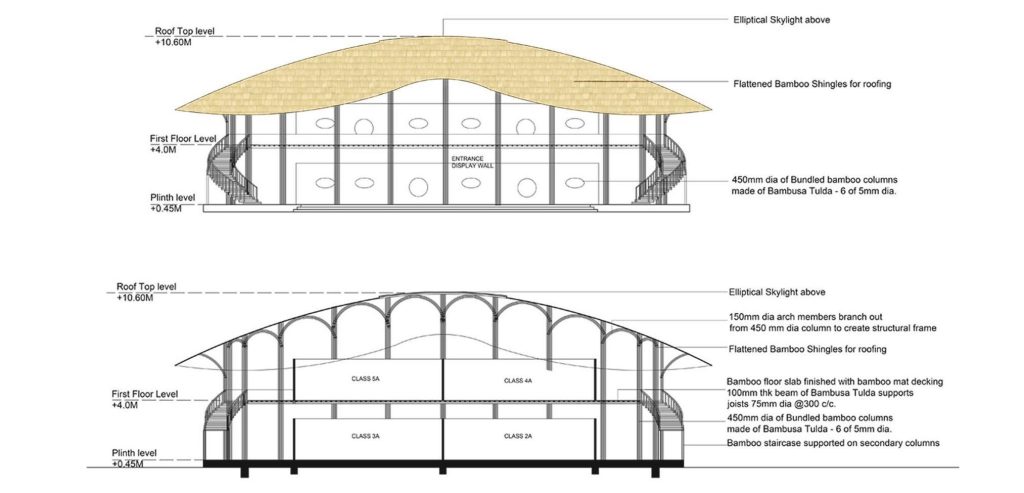
Typical Classroom Block
Hostile architecture is an eyesore and fast changing the urban landscape of prominent cities around the world. Architecture is meant to benefit the people / users at large, but the effects of hostile architecture are targeting people and depicting wickedness of the society and is against the ethos of architecture field. Elucidate your perspective about this unwanted trend in urban landscape.
I believe that urban landscapes should prioritize the well-being of every individual. Hostile architecture is harmful for society’s culture and cohesion and may eventually lead to social isolation. I advocate for more humane design interventions that shape behaviors inclusively and equitably. I strongly believe in human-centered design approach for urban spaces.
Which significant aspects of the global platform ‘zerobeyond – the new frontier!’ did you liked the most, and why?
‘zerobeyond – the new frontier!’ has provided a motivating platform for young and promising architects to voice their opinions, ideas and visions – something that is uncommon. The Gen Z Series is refreshing to engage with, as it provides a window into the stories of fellow student architects from across the planet. The stories and projects showcased carry an authentic and honest energy!

Site Section XX’
How will the younger generation of architects make drastic innovative changes to mitigate the catastrophic effects of Climate Crisis? Elucidate your solution(s) and perspectives.
Transitioning to a circular economy in the construction industry is the key to mitigating climate change in this hour of climate crisis. It is important for younger architects to become aware of concepts like LCA – Life Cycle Assessments of buildings. While we conceive thoughtful designs, their realization into physical structures consumes significant resources and materials.
We can choose low-carbon material alternatives, for example, to reduce the carbon footprint of buildings. I have also come to realize the importance of preserving existing structures, as much as possible, opting for retrofitting over demolition and repurposing vacant buildings to maximize their utility.
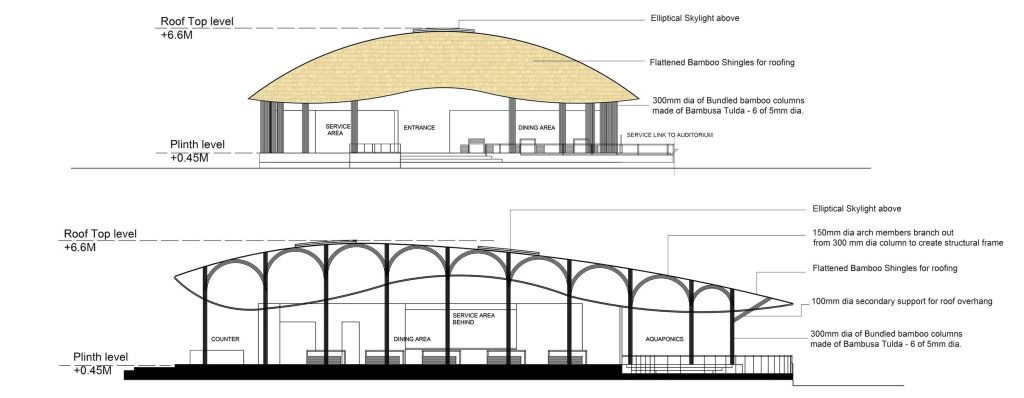
Canteen
Local charm of cities has diminished due to Modern Architecture as every city looks alike and similar. How should architects / urban planners / landscape architects modernize cities, while maintaining the local charm intact?
Globalization has consumed the uniqueness of each city. To preserve the local charm of a place, designers must adopt a contextual approach considering its geographical location, climate, historical character, locally available materials and unique climate-responsive design strategies. If the look and feel of a building enhances the contextual character of the city, it contributes to the collective urban memory of visitors and instills pride in the residents.

Site Section YY’
Looking at the past in the current present, what are the futuristic architectural changes you would like to see in your home city / town? Elucidate the reasons for your vision.
Bangalore, my hometown, was once renowned as the ‘Garden City’ adorned with numerous lakes and plenty of trees. Its evolution into an ‘IT hub’ has led to the depletion of lakes and greenery. Encroachment of lakes by buildings has led to the city facing a water crisis. I wish for Bangalore to reclaim its ‘greener past’. At the urban level, I wish for the city to get relief from urban flooding by employing nature- based solutions for drainage mechanisms. Architecturally, I would like to see existing buildings being utilized to their fullest potential through renovation and retrofitting.

Construction Details
Honours and awards related to architecture, if any.
Having completed my Bachelor’s degree in Architecture, I was awarded the 5th rank in the State of Karnataka by the State University, VTU – Visvesvaraya Technological University.
Further, I was grateful to receive the Global Excellence Scholarship by University College Dublin, to pursue my current Master’s degree.
Such recognitions motivate me to continue working hard and aspire to achieve even greater accomplishments!
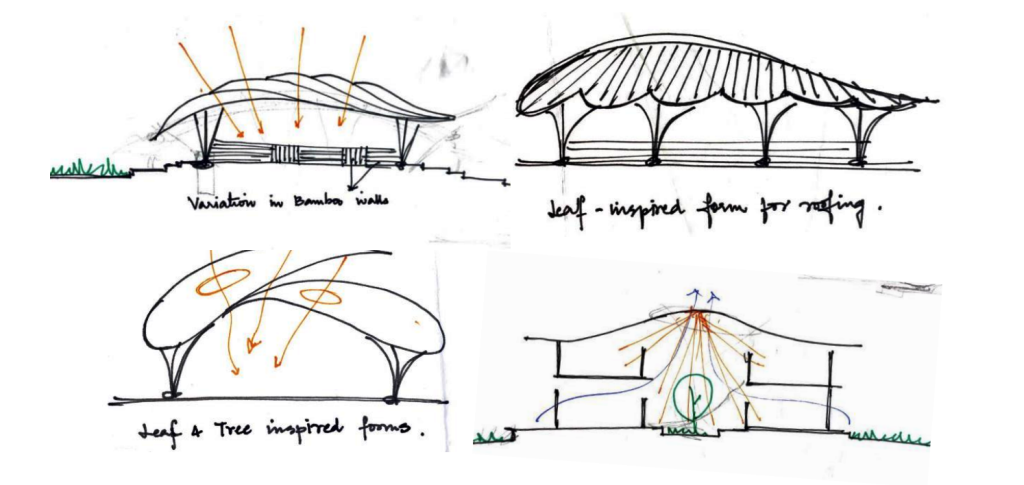
Preliminary Sketches
Image Courtesy: Jaspreet Kaur